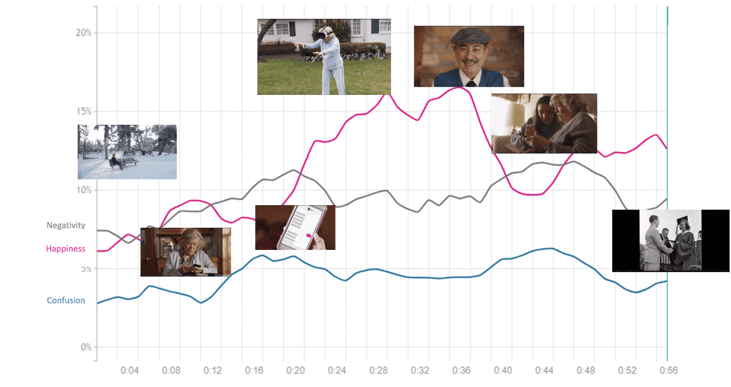T-Mobile’s “Grandma” commercial does a lot of things well and looks like a warm, sentimental hit on the surface, but there are two significant missteps where the ad loses crucial emotional momentum. In the end, the advertisement scores right at the 68th percentile among the 13,000 ads in our normative database. We analyzed facial coding results from over 300 people and saw “Grandma” with its fair share of highs and lows.
“Grandma” Advertising Testing Results

- The ad gets off to a decent start, buoyed by the scene of her floating on a pink tube in a pool (no pun intended). Not quite the levels of Surprise we’d want out of the gate to optimize attention, but still OK.
- Negativity and Confusion peak during scenes of Grandma sitting at the table looking at the phone, throwing a pillow at the camera and looking at text messages (although visually it’s not clear who is sending/why there are so many). These scenes suppress any momentum built so far and could be shortened or eliminated.
- Following this, engagement (including Happiness) builds strongly and holds its peak for a while during both gaming (zombie death!) and online dating scenes. These are the ones to use in shorter versions of the spot.
- The second letdown comes when a granddaughter (or some other young woman) is helping grandma sort through pictures in a shoebox – when “everyone had been too busy wondering how grandma was.” The introduction of this “problem” evokes a high level of Negative emotion and confusion. This negative tension can be helpful, although this scene (and accompanying voiceover) could have been shortened to leave more time to build toward the end, which is mostly successful.
- Shots of grandma’s memorable life events build Happiness slowly until the end (pushed higher by females). Unfortunately, this ad ends with only modest Happiness as we would like to see from a higher-performing ad. Kahneman argued that peak happiness should come at the end of an ad to make it memorable and impart a lasting impression on the viewer. This ad, though creating Happiness at the end, does not end with high levels like we want to see from a high-performing ad.
Final Insights on “Grandma”
Of course, this emotional assessment of the ad is incomplete, as core metrics of Appeal, Relevancy, Salience, etc. were not captured. T-Mobile’s Grandma commercial performed well enough to be memorable and invoke Happiness. With facial coding, we can see the opportunities for improvement – allowing it to perform even better!
The more we use facial coding to analyze the second-by-second performance of ads, the more we’re impressed. It is a tool not to be left in the advertising testing bag.
Further Resources
For further reading on advertisement testing, MDRG analyzed 2019’s Super Bowl commercials using facial coding in this blog.
Are you eager to stay ahead of the curve in your industry? Sign up for our monthly insights email and gain exclusive access to valuable market research, industry trends, and actionable recommendations delivered directly to your inbox.
Topics from this blog: Advertising Consumer Insights Market Research